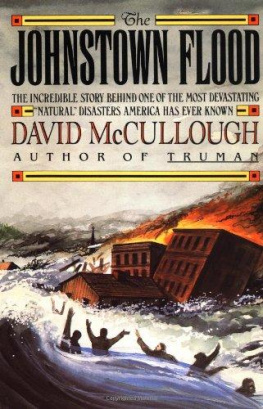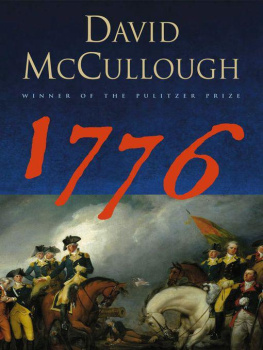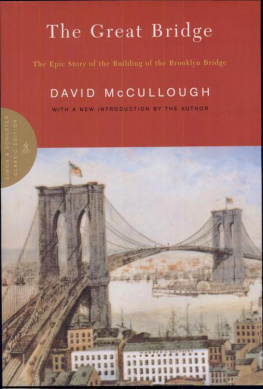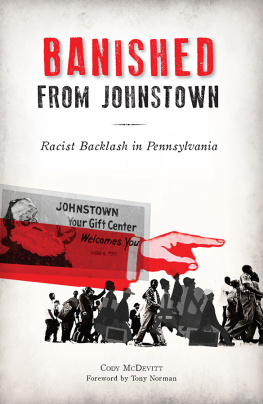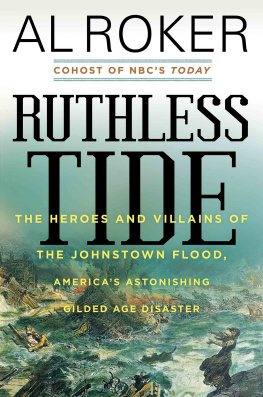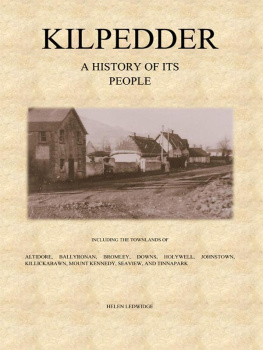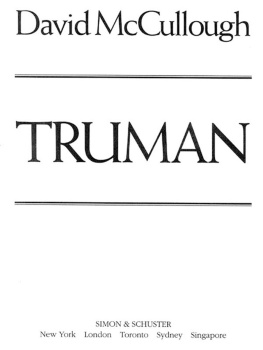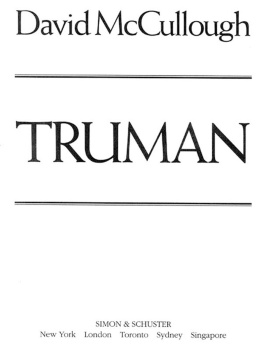
Simon & Schuster
Rockefeller Center
1230 Avenue of the Americas
New York, NY 10020
Copyright 1968 by David McCullough
All rights reserved,
including the right of reproduction
in whole or in part in any form.
S IMON & S CHUSTER and colophon are registered trademarks of Simon & Schuster, Inc.
The Library of Congress has cataloged the Touchstone edition as follows:
McCullough, David G.
The Johnstown flood.
(A Touchstone book)
Bibliography: p.
1. FloodsPennsylvaniaJohnstown. 2. Johnstown (Pa.)History. I. Title.
[F159.J7M16 1987] 974.877 86-26056
ISBN-13: 978-1-4165-6122-4
ISBN-10: 1-4165-6122-6
For Rosalee
Acknowledgments
The material for this book was gathered from the files of newspapers, from unpublished reminiscences, from letters and diaries, from Johnstown Flood histories that were best sellers in their day and from books and pamphlets that were privately printed, from court records, engineering reports, local histories, and rare old maps, from old photographs, and from hours of taped conversations with survivors of the Johnstown Flood.
A bibliography is included at the back of the book, but I want to acknowledge my indebtedness to four works in particular: J. J. McLaurins The Story of Johnstown, which for all its Victorian embellishments and inaccuracies is the finest by far of the books gotten up by journalists in 1889; The Reverend David J. Beales Through the Johnstown Flood, in many ways the best book on the flood and unquestionably the best-written and most reliable of accounts by survivors; A History of Johnstown and the Great Flood of 1889: A Study of Disaster and Rehabilitation, which is a doctoral thesis written by the late Nathan D. Shappee and the only scholarly study of the disaster; and a recently discovered transcription of testimony taken by the Pennsylvania Railroad during the summer of 1889, which has been invaluable. (Most of the dialogue in Chapters 3 and 4, for example, has been taken directly from this transcription, which, in all, runs to nearly 500 typewritten pages, and no part of which has been previously published.)
I very gratefully acknowledge my debt to the following flood survivors who kindly gave me so much of their time to talk about their experiences, some of whom have since passed on: Mrs. Kate Miltenberger, Mr. and Mrs. Harry Hesselbein, and David Fetterman, all of Johnstown; U. Ed Schwartzentruver of South Fork; Mrs. Gertrude Quinn Slattery of Wilkes-Barre, who also read the manuscript; and Dr. Victor Heiser of New York, who, in addition to vivid descriptions of his own experiences, supplied wonderful insights into the Johnstown of the 1880s, and who read the manuscript.
I am grateful also to the two Johnstown ladies, both survivors, who shared memories of their illustrious family, but who asked that I not mention their names.
I wish to thank too the many others in Johnstown who were helpful, and especially the following: Irving London, who led me to the Pennsylvania Railroad testimony and who made available his extraordinary collection of flood photographs; Harold Strayer; Gustaf Hultman of the National Park Service; Elit Felix; Walter Krebs, president of the Johnstown Tribune-Democrat, who made available the papers reference library and files; Don Matthews, Jr., also of the Tribune-Democrat, who made numerous helpful suggestions; Frank Dell and Ron Stephenson of Station WJAC; the City Clerks office; and the staff of the Cambria Public Library.
In addition, I am much indebted to Edna Lehman, who made available important documentary material at the Cambria County Historical Society at Ebensburg; to the late Robert Heppenstall of Pittsburgh, for information on his fathers heroic action; to Mrs. John E. Hannon, Sr., of Detroit, who wrote to me at length about her grandfather, W. Horace Rose; to Mrs. Bernard McGuire of Cresson, who let me borrow a diary kept by her grandfather, Isador Lilly of Ebensburg; to Dr. Philip Bishop, Dr. John White, and Donald Berkebile of the Smithsonian Institution; to Mr. and Mrs. Fred Livengood, Sr., of Somerset; to the late Mrs. O. C. Gaub of Pittsburgh; to Evan Stineman of South Fork; and to Al Danel of St. Michael, Pennsylvania.
Also I wish to express my gratitude for the facilities offered by the staff of the Pennsylvania Room at the Carnegie Library, Pittsburgh; the Allegheny County Court of Claims, Pittsburgh; the Local History and Genealogy Room at the New York Public Library; the New York Historical Society; the Library of Congress; the University of Pennsylvania; the University of Pittsburgh; the Yale University Library; the White Plains Public Library; and the Boston Public Library.
And for their suggestions and encouragement I wish finally to thank Walter McQuade, Walter Lord, Roger Butterfield, David Plowden, Heywood Broun, Jr., David Allison, Frank Fogarty, James Morrison, Royall OBrien, Charles T. Siebert, Jr.; Audre Proctor, who typed the manuscript; my mother and father; and my wife, Rosalee.
D. McC.
Contents
List of Illustrations
I The sky was red
II Sailboats on the mountain
III Theres a man came from the lake.
IV Rush of the torrent
V Run for your lives!
VI A message from Mr. Pitcairn
VII In the valley of death
VIII No pen can describe
IX Our misery is the work of man.
List of Victims
Bibliography
THE JOHNSTOWN FLOOD
We are creatures of the moment; we live from one little space to another; and only one interest at a time fills these.
William Dean Howells
in A Hazard of New Fortunes, 1889.
The sky was red
Again that morning there had been a bright frost in the hollow below the dam, and the sun was not up long before storm clouds rolled in from the southeast.
By late afternoon a sharp, gusty wind was blowing down from the mountains, flattening the long grass along the lakeshore and kicking up tiny whitecaps out in the center of the lake. The big oaks and giant hemlocks, the hickories and black birch and sugar maples that crowded the hillside behind the summer colony began tossing back and forth, creaking and groaning. Broken branches and young leaves whipped through the air, and at the immense frame clubhouse that stood at the waters edge, halfway among the cottages, blue wood smoke trailed from great brick chimneys and vanished in fast swirls, almost as though the whole building, like a splendid yellow ark, were under steam, heading into the wind.
The colony was known as the South Fork Fishing and Hunting Club. It was a private summer resort located on the western shore of a mountain lake in Cambria County, Pennsylvania, about halfway between the crest of the Allegheny range and the city of Johnstown. On the afternoon of Thursday, May 30, Memorial Day, 1889, the club was not quite ten years old, but with its gaily painted buildings, its neat lawns and well-tended flower beds, it looked spanking new and, in the gray, stormy half-light, slightly out of season.
In three weeks, when the summer season was to start, something like 200 guests were expected. Now the place looked practically deserted. The only people about were a few employees who lived at the clubhouse and some half dozen members who had come up from Pittsburgh for the holiday. D. W. C. Bidwell was there; so were the young Clarke brothers, J. J. Lawrence, and several of the Sheas and Irwins. Every now and then a cottage door slammed, voices called back and forth from the boathouses. Then there would be silence again, except for the sound of the wind.

